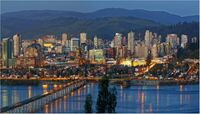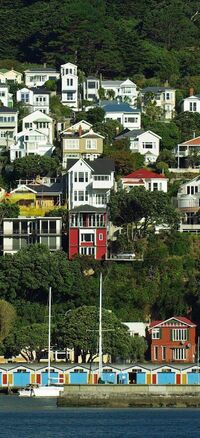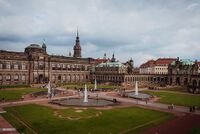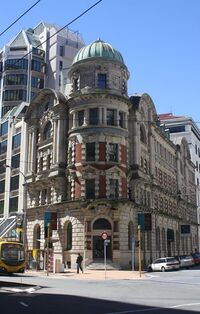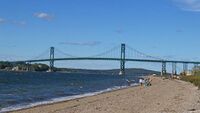Greycott: Difference between revisions
No edit summary |
|||
| Line 271: | Line 271: | ||
| source = New Gough Island Weather Service | | source = New Gough Island Weather Service | ||
}} | }} | ||
==Neighborhoods== | |||
{{Template:Anteria info pages}} | {{Template:Anteria info pages}} | ||
[[Category:Anteria]] | [[Category:Anteria]] | ||
[[Category:New Gough Island]] | [[Category:New Gough Island]] | ||
Revision as of 21:53, 9 May 2024
Hartridge | |
|---|---|
City | |
From top to bottom: Hartridge skyline seen from across the Hartridge River in Gough City at night, Hartridge skyline day, Cayman Street in Downtown Hartridge, A residential neighborhood in Hartridge, Victorian houses, Hartridge University, Old National Bank Building, New Gough Island National Art Gallery, Hartridge City Hall, Hartridge River Bridge (opened in 1929) | |
| Country | New Gough Island |
| Region | South Peninsula |
| Municipality | Hartridge |
| Government | |
| • Mayor | Lisa Haddock (LDP) |
| Area | |
| • City | 65 sq mi (170 km2) |
| • Land | 40 sq mi (100 km2) |
| • Water | 25 sq mi (60 km2) |
| • Urban | 410 sq mi (1,100 km2) |
| • Metro | 1,545 sq mi (4,000 km2) |
| Population (2024) | |
| • City | 254,000 |
| • Density | 6,350/sq mi (2,450/km2) |
| • Urban | 1,290,000 |
| • Urban density | 3,146.3/sq mi (1,214.8/km2) |
| • Metro | 1,680,000 |
| • Metro density | 1,087.4/sq mi (419.8/km2) |
| Demonym | Hartridger |
Hartridge is a city in New Gough Island. It is the largest city in the country, home to 254,000 people as of 2024. The Greater Hartridge Area is home to 1.68 million people in the South Peninsula Region. The Greater Hartridge area takes up 75% of the region's population in 33% of the region's area. On the national scale the area takes up 26% of the population in 2.6% of the national land area. Other cities in the area include the capital of South Peninsula Region, Gough City which is across the river from Hartridge. And the country's 8th largest city and suburb of Hartridge, Berman. The city is cosmopolitan for its size. It is the financial and banking center of the country. It is home to the tallest building in the country, the Majestic Center Tower which is 30 Storeys and 381 feet (116 meters) tall. The city is home to the majority of the national and international corporations in the country and the Hartridge Stock Market. It is also home to the New Gough Island National Art Gallery, the most prestigious university in the country, Hartridge University. The city is famous for its Victorian, Edwardian, Neoclassical, and Modern architecture styles.
History
Geography
The Greater Hartridge Area is located in the Hartridge River Valley, sandwiched between the Southern Coastal Ranges. The valley plain isn't flat but quite hilly. The Hartridge River is at its widest point 1.5 miles (7.920 feet or 2,414 meters) at its mouth. The tallest mountain in the Greater Hartridge Area is Mount Baylee which is 5,612 feet (1,710.5 meters) tall. Hartridge is located on the west bank of the Hartridge River while it's twin city, Gough City is on the east bank. Downtown Hartridge is located 4 miles (6.4 km) from the mouth of the river. There are hills that block Downtown Hartridge from the sea and its southern neighborhoods.
Climate
The climate of Hartridge is Oceanic. With wet rainy conditions all year round. During the summer it is mildly warm and less rainy. Temperatures decline in the autumn and the frequency rain increases. Snow can occur during the months of June through August. Though heavy long-lasting snow is uncommon. Cold waves are common with temperatures reaching 25 degrees F (4 degrees C) on July 15, 2012. The heaviest snowstorm happened on July 14, 2012 when it brought 6.8 in (17 cm) of snow. The coldest high temperature ever recorded was 36 degrees F (2 degrees C) on July 15, 2012. The wet cool spring gives way to summer when heatwaves can take place. With the hottest temperature ever recorded was 86 degrees F (30 degrees C) on January 2, 1997, the warmest overnight temperature was 72 degrees F (22 degrees C) on January 15, 2014. While the city receives a lot of rainfall through the year, the rainiest year was 1984 with 171.4 in (4,354 mm) while the driest year was 1990 with 40.2 in (1,021 mm). The wettest month was July 1999 with 20.8 in (528 mm). The wettest day was August 4, 1955 when 8.4 in (213 mm) of rain fell in 24 hours. The direst month was January 1990 with only 0.9 in (23 mm) rain fell. The snowiest month was July 2012 with 14.1 in (36 cm) of snow fell. The snowiest season was in 1996 with 24 in (61 cm) of snow.
| Month | Jan | Feb | Mar | Apr | May | Jun | Jul | Aug | Sep | Oct | Nov | Dec | Year |
|---|---|---|---|---|---|---|---|---|---|---|---|---|---|
| Record high °F (°C) | 86 (30) |
85 (29) |
81 (27) |
79 (26) |
73 (23) |
68 (20) |
65 (18) |
69 (21) |
74 (23) |
77 (25) |
80 (27) |
84 (29) |
86 (30) |
| Average high °F (°C) | 70.2 (21.2) |
68.0 (20.0) |
63.6 (17.6) |
59.4 (15.2) |
55.2 (12.9) |
52.5 (11.4) |
49.3 (9.6) |
50.8 (10.4) |
53.9 (12.2) |
57.3 (14.1) |
62.1 (16.7) |
66.3 (19.1) |
59.0 (15.0) |
| Daily mean °F (°C) | 64.8 (18.2) |
62.1 (16.7) |
58 (14) |
54.3 (12.4) |
50.8 (10.4) |
48.7 (9.3) |
45.4 (7.4) |
46.6 (8.1) |
49.8 (9.9) |
52.8 (11.6) |
58 (14) |
61.2 (16.2) |
54.4 (12.4) |
| Average low °F (°C) | 59.3 (15.2) |
56.1 (13.4) |
52.4 (11.3) |
49.1 (9.5) |
46.4 (8.0) |
44.8 (7.1) |
41.6 (5.3) |
42.3 (5.7) |
45.6 (7.6) |
48.2 (9.0) |
53.8 (12.1) |
56.2 (13.4) |
49.7 (9.8) |
| Record low °F (°C) | 39 (4) |
37 (3) |
35 (2) |
32 (0) |
29 (−2) |
27 (−3) |
25 (−4) |
28 (−2) |
30 (−1) |
34 (1) |
36 (2) |
38 (3) |
25 (−4) |
| Average rainfall inches (mm) | 5.4 (140) |
5.9 (150) |
6.3 (160) |
6.8 (170) |
7.4 (190) |
7.9 (200) |
9.8 (250) |
9.5 (240) |
7.7 (200) |
7.1 (180) |
6.5 (170) |
6.0 (150) |
86.3 (2,200) |
| Average rainy days (≥ 0.1) | 9 | 10 | 11 | 12 | 13 | 13 | 16 | 16 | 14 | 13 | 12 | 10 | 149 |
| Source: New Gough Island Weather Service | |||||||||||||
Neighborhoods
